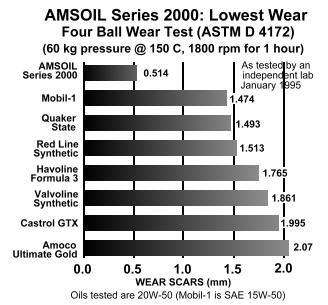|
When AMSOIL
created the Series 2000 20W-50 Racing Oil, it seems the
competitiongot upset with the testing results showing it's better
protection. For years Red
Line advertised that they provided the best protection, but
the results of the Four Ball Wear Test showed the
AMSOIL Series 2000
20W-50 providing over twice the protection.
Red Line decided
that they would perform their own test by running both oils and then
seeing what results they would come up with. Their results some how
showed their oil to be better. In an attempt to discourage the
promotion of AMSOIL
they mailed this information to all
AMSOIL
Dealers as well as their own reps. The findings of the Four Ball
Wear Test were that of 100 tests and coming up with an average.
Unlike the Red Line
test, it could be proved
over and over, under proper testing conditions. Rather than
going along with the hype that this action provoked,
AMSOIL simply
issued the following letter:
Recently Red Line Synthetic Oil Corporation mailed an article to
AMSOIL
Dealers outlining results of testing done on
AMSOIL
Series 2000 Synthetic 20W-50 Racing Oil and Red Line products.
AMSOIL finds
the article flawed in both its marketing approach and scientific
methodology.
Initial Red Line testing of an unused sample of
AMSOIL Series
2000 20W-50 Racing Oil in the ASTM D4172 Four Ball Wear Test yielded
results consistent with those appearing on the Series 2000 label.
That is, AMSOIL
Series 2000 20W-50 provided
nearly three times better
wear protection than
Red Line 20W-50.
The article, however, goes on to report results of
used oil testing using the ASTM D4172 Test. ASTM tests, as any
informed entity in the lubricants industry knows, are designed for
use with new (unused) lubricants, not used oil.
There are two problems with testing used oil.
First, the conditions of testing are uncontrollable. While Red Line
states the service conditions under which the samples operated were
the same, variables including fuel and glycol dilution, contaminant
levels, filtration, driving conditions sampling techniques and many
more are virtually impossible to control.
The second problem is repeatability,
AMSOIL
attempted to replicate Red Line's findings by testing samples of
used oil. The results were inconsistent with Red Line's and failed
to meet the repeatability requirements of the ASTM D4172 test
method. This failure is the result of testing an oil along with its
contaminants.
Red Line's claim that their oil is designed to become more effective
as it reacts with blow by gases is absurd. Clearly, if blow by gases
improved the anti-wear characteristics of lubricants, then lubricant
manufacturers would expose their products to such gases during the
manufacturing process. The fact is, lubricant performance should not
depend on the uncontrollable reactions of blow by gases with the
oil.

|

